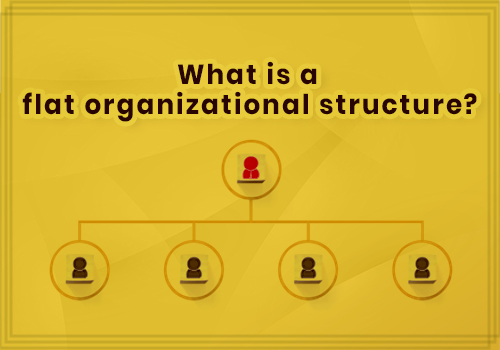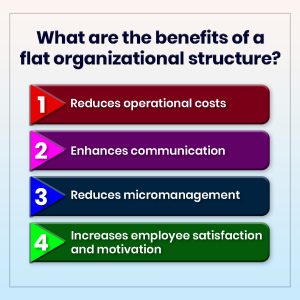
A flat organizational structure is an emerging trend where there are no hierarchies in the workplace and people are given more autonomy to make decisions and implement their initiatives.
The organizational structure can play a significant role in determining a company’s success. Ineffective structures can lead to issues such as poor communication, substandard performance, and high attrition. Modern organizations must try to use more efficient organizational structures to avoid such issues, and ensure flexibility and agility, along with rapid alignment to the evolving market dynamics.
An organizational structure refers to the management system that directs the entire activities of an enterprise, encompassing the manner in which the organization is structured and the relationships among the employees. It is usually a visual diagram that depicts the roles of the employees, reporting structure, and the decision-making process.
The types of organizational structures found in the business world are Hierarchical organizational structure, Functional organizational structure, Matrix organizational structure, Horizontal or flat organizational structure, Team-based organizational structure, Divisional organizational structure, and Network organizational structure.
Among these, the best-suited structure for modern businesses is definitely the Flat organizational structure. This type of organizational structure is popular because it allows for enhanced flexibility and creativity in the workplace. In these organizations, employees gain the freedom to take initiative without worrying about the manager’s reaction.
What is a flat organizational structure?
Flat structure organization is a concept that has been around for a while. However, it has gained popularity only recently with the boom of the internet and new business models. A flat organizational structure eliminates unnecessary levels of management and provides more authority at the worker level. It is organized in such a way that all employees have equal access to decision-making power and information.

A flat structure organization differs widely from the traditional hierarchical form that follows a rigid reporting hierarchy of workers, front-line managers, middle managers, and top-level managers. The flat structure establishes a decentralized and flexible structure with fewer management levels and encourages the practice of workers directly reporting to higher-level managers. This increases the autonomy of the workers and eliminates bureaucracy. The employees in a flat structure organization are connected through various communication channels like telephone, chat, email, etc and as a result, the employees can collaborate, work more effectively, and make quick decisions.
We are shifting toward a societal mindset that disapproves of rigid authority or command control. The millennials who form a big portion of the workforce believe in initiatives and risk-taking. To support this shift in mindset, organizations need to implement flat structures, trust the capabilities of their employees, and allow them to experiment with their innovative ideas even if they are wrong.
A flat organizational structure is workable in all organizations regardless of their size. However, it might need to be adapted to each organization based on the existing degree of authority and structure. While implementing a flat structure, all stakeholders need training to ensure a smooth transition. The management team and employees will definitely need time to be accustomed to the new model of workflow and hence multiple training sessions have to be organized for aligning their mindset with the flat organizational structure. The training has to be structured around the individual needs and capabilities and apart from this regular audits need to be in place for eliminating process deviations.
What are the benefits of a flat organizational structure?

Flat structures promote collaboration, creativity, and innovation. Furthermore, this enables a quicker response to changes in the marketplace. Also, flat-structured organizations do not have any formal hierarchy or management positions, which means that anyone can easily move up the ladder if they prove themselves. This also allows employees to be more creative and innovative because they can move around without being tied down to one role.
Reduces operational costs
In a flat organization, decision-making happens at the staff level, not at the executive level. Employees have a lot of authority with little to no supervision. As a result, companies do not have to hire mid-level and lower-level managers and instead divert the budget to enhance the core business operations. Typically, flat structures do away with all managers except for executive-level managers, which allows you to run a leaner operation and get more productivity per employee.
Enhances communication
Due to the number of management layers between executives and staff workers, tall organizational structures have the disadvantage of slow communication. A flat organizational structure allows executives and employees to communicate directly without requiring intermediaries. In addition to speeding up communication, it also makes it clear and understandable, as clarity is often compromised when more people are involved in communication.
Reduces micromanagement
Many companies have multiple managers who tend to micromanage all the daily tasks of the employees. In companies where micromanagement is prevalent, employees may feel as if they cannot make any decisions without being criticized. This results in inefficiency. Managers who lack trust in their subordinates often slow down work processes by requiring several approvals before employees can carry on with a project.
Increases employee satisfaction and motivation
Those working in flat-structured organizations have the freedom to implement their ideas and methods so long as they provide the desired results. These empowerments boost productivity, as well as employee motivation. Trust motivates workers to strive for excellence and to utilize all their skills and talents for the benefit of the company. Having motivated employees leads to higher employee satisfaction and, more importantly, staff buy-in.
Is a flatter organizational structure right for your business?
Flat organizations are often considered to be the future. In recent years, many businesses have adopted this form of organization in order to improve their efficiency and productivity. Despite the advantages of this organizational structure, it can also present challenges, particularly for large businesses. However, the benefits of a flat organizational structure might far outweigh the disadvantages, and today many companies are moving toward flat structures as it enhances employee engagement and productivity.
What makes a good company culture?
Low levels of employee attrition, good rewards and recognition, and transparent communication make a good company culture.
What are the key elements of organizational culture?
Open communication, innovation, trust, and collaboration are the key elements of a good organizational culture.
What 3 words describe the culture of a company?
Collaborative, flexible, and inclusive
What is a good working environment?
A good working environment encourages open and transparent communication and promotes innovation.
How do you evaluate organizational culture?
Transparency among the leaders, progressive rewards and recognition programs, and open team interactions are great measures of organizational culture.
What are the 4 Benefits of a flat organizational structure?
Reduces operational costs
Enhances communication
Reduces micromanagement
Increases employee satisfaction and motivation



